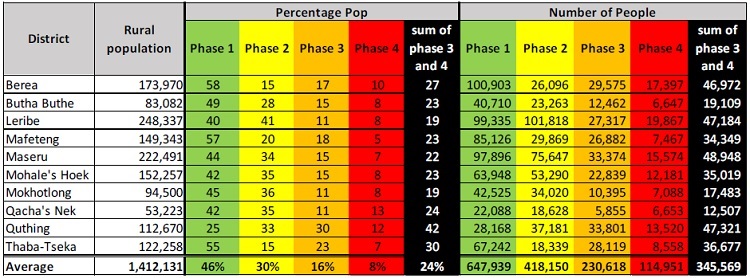31.05.2016
31.05.2016 > 31.03.2017
Map
Projected Map
Other Projections



- IPC in Lesotho - Summary Results
- IPC Acute Food Insecurity Analysis in the Region:
Key
results
Population
estimates
Recommendations
& next steps
Acute
Malnutrition
In the May-June 2016 period eight districts out of ten, i.e. Mafeteng, Leribe, Berea, Qacha’s Nek, Quthing, Mokhotlong, Thaba-Tseka, and Butha Buthe are classified as Phase 2 ‘Stressed’. Two districts (Maseru and Mohale’s Hoek) are in Phase 3 ‘Crisis’. There is no district that is classified in Phase 4, although all districts have population ranging from 4 to 15) that are thought to be facing an emergency food insecurity situation (Phase 4). All in all 44% of the total rural population are expected to be in Phase 1 (‘No/Minimal Acute Food Insecurity’), 34% in Phase 2 (‘Stressed’), 13% in Phase 3 (‘Crisis’), and 8% in Phase 4 (‘Emergency’).
First projection from July to October 2016: this is typically a post-harvest period when households have some food stock from their own production, and food prices are relatively stable with slight increases towards the end of the period. This year, however, very few if any households have stocks due to very poor harvest. This means that households become market dependent sooner than usually during the projection period. Food prices are expected to be higher than average and increasing due to lack of domestic production, and higher demand, and the dependence on imports from South Africa. Prices, even with government subsidies, are expected to increase by 15-25% compared to average over the projection period in all districts. In Mokhotlong, however, prices are expected to dramatically increase by up to 70%. In total, it is estimated that between 20 and 31% of the rural population will experience No or Minimal acute food insecurity (IPC Phase 1), 33% will be in Phase 2 (‘Stressed’), 26% in Phase 3 (‘Crisis’), and 11% in Phase 4 (‘Emergency’). The worst affected households, classified Phases 3 and 4, are typically the poor and very poor, who lack sufficient income to purchase food at higher food prices, as well as those who have already depleted or will deplete their main livelihood assets, such as livestock, in order to cover their food and non-food needs. All the districts are expected to be in Phase 3 ‘Crisis’ in the projection period, with typically up to a maximum of 15% of the population in Phase 4 ‘ Emergency’ by district.
Second projection from November 2016 to March 2017: Rainfall in the post-harvest period is typically very low, condition confirmed by rainfall forecast for 2016. Since water levels are already low due to poor rainfall, it is likely that the wheat harvest taking place early in the second projection period will be lower than usual. The peak of the lean season, normally taking place from December to February, is expected to manifest earlier (December) and more severely than usual due to depleted stocks, low winter wheat harvest and high food prices. Despite these conditions, it is still expected that food security situation is somewhat better compared to the first projection period. This is due to the fact that many households are expected to be able to increase their income by engaging in casual labour, given that the expected ‘La Nina’ phenomenon could bring ample rains to the county starting in October, thus increasing demand for agricultural labour. In the peak of the lean season, this source of income is likely to facilitate households’ access to food. In addition, social safety net programmes and food subsidies, are expected to lessen the impact of the lean season. In general, 46% of the rural population is expected to remain in IPC Phase 1, 29% will be in Phase 2 ‘Stressed’, 16% in Phase 3 ‘Crisis’, and the remaining 8% will be in Phase 4 ‘Emergency’. All the districts, except Leribe and Mokhotlong, will remain in Phase 3 ‘Crisis’ over the second projection period, with between 5 and 13% of rural population in Phase 4.
Country Related Information
Contacts
- 01.01.2025 > 31.03.2025
Lesotho: Acute Food Insecurity Projection Update January - March 2025 - 01.05.2024 > 31.03.2025
Lesotho: Acute Food Insecurity Situation for May - September 2024 and Projection for October - March 2025 - 01.07.2023 > 31.03.2024
Lesotho: Acute Food Insecurity Situation for July - September 2023 and Projection for October - March 2024 - 01.07.2022 > 31.03.2023
Lesotho: Acute Food Insecurity Situation July - September 2022 and Projection for October 2022 - March 2023 - 01.11.2021 > 31.03.2022
Lesotho: Acute Food Insecurity Situation November - December 2021 and Projection for January - March 2022 - 01.07.2021 > 31.03.2022
Lesotho: Acute Food Insecurity Situation July - September 2021 and Projection for October 2021 - March 2022 - 01.07.2020 > 31.03.2021
Lesotho: Acute Food Insecurity Situation July - September 2020 and Projection for October 2020 - March 2021 - 01.05.2019 > 31.03.2020
Lesotho: Acute Food Security Situation May - September 2019 and Projection for October 2019 - March 2020 - 01.12.2018 > 28.02.2019
Lesotho: Acute Food Insecurity Situation December 2018 - February 2019 - 01.05.2018 > 28.02.2019
Lesotho: Acute Food Insecurity Situation in May-August 2018 and Projection for September 2018 - February 2019 - 01.07.2017 > 31.03.2018
Lesotho: Acute Food Insecurity Situation in July-September 2017 and Projection for October-March 2018
- 28.06.2025 > 05.07.2025
Lesotho: Acute Food Insecurity Analysis - 02.12.2024 > 06.12.2024
Lesotho: Acute Food Insecurity Analysis (Projection Update) - 22.05.2024 > 30.05.2024
Lesotho: Acute Food Insecurity Analysis - 10.07.2023 > 15.07.2023
Lesotho: Acute Food Insecurity Analysis
Join our mailing list




